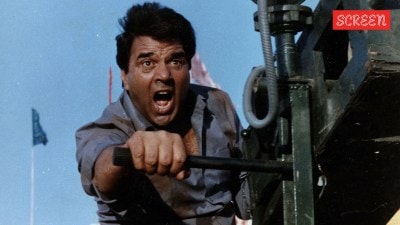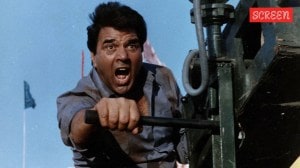Click for more updates and latest Hollywood News along with Bollywood and Entertainment updates. Also get latest news and top headlines from India and around the World at The Indian Express.
Christopher Nolan’s Oppenheimer: A look at the scientist’s fascination with Hinduism, and why he quoted the Bhagavad Gita after the bomb was tested
Christopher Nolan's upcoming film has reawakened interest in nuclear physicist J Robert Oppenheimer's fascination with the Hindu religion.
 Cillian Murphy as J Robert Oppenheimer (L) and the real man (R).
Cillian Murphy as J Robert Oppenheimer (L) and the real man (R). As fans in India excitedly wait for the release of Christopher Nolan‘s new film, Oppenheimer, many have revisited the famed nuclear physicist’s iconic reference to the Bhagavad Gita. J Robert Oppenheimer has often quoted from the sacred text, making the words synonymous with his achievements.
Oppenheimer’s research resulted in the creation of the first nuclear bombs. He immediately understood the gravity of what he had helped create, and has often said that the first words that ran through his mind after the bomb was successfully tested in the New Mexico desert in 1945 were from the Gita: “If the radiance of a thousand suns were to burst into the sky, that would be like the splendor of the Mighty One… I am become death, the shatterer of worlds.”
According to Time Magazine, Oppenheimer read the Gita for his ‘personal delight’ in the evenings, and sometimes to entertain friends. A copy of the sacred text, bound in pink and held together by scotch tape, was placed in his Princeton study. He took lessons in Sanskrit, his eighth language, from Professor Arthur W Ryder at Berkeley, and was particularly fond of the couplet, “Scholarship is less than sense, therefore seek intelligence.” According to his colleague, the Nobel Prize winner Isidor Rabi, Oppenheimer was ‘overeducated’ in fields that ‘lie outside the scientific tradition’, such as his interest in the Hindu religion. Rabi said, “He saw physics clearly, looking toward what had already been done, but at the border he tended to feel there was much more of the mysterious and novel than there actually was… [he turned] away from the hard, crude methods of theoretical physics into a mystical realm of broad intuition.”
A Time Magazine report published in 1948 recounted his story, and quoted Brigadier General Thomas F Farrell as describing Oppenheimer’s demeanour on the fateful day. “He grew tenser as the last seconds ticked off. He scarcely breathed. He held on to a post to steady himself . . . When the announcer shouted ‘Now!’ and there came this tremendous burst of light, followed … by the deep-growling roar of the explosion, his face relaxed into an expression of tremendous relief.”
Years later, he would still be impacted by the ethical complexities of creating a bomb capable of such destruction. Deployment of two atom bombs on the Japanese cities of Hiroshima and Nagasaki effectively brought World War 2 to an end. But the destruction caused by something that he had helped create confirmed Oppenheimer’s fears. He told fellow physicists, according to the obituary that the New York Times published on his death in 1967, that the bomb “dramatised so mercilessly the inhumanity and evil of modern war.” He added, “In some sort of crude sense which no vulgarity, no humor, no overstatements can quite extinguish,” he went on, “the physicists have known sin; and this is a knowledge which they cannot lose.”
In a news interview following the bombings on Japan, Oppenheimer once again recalled the emotions that were felt in the control room on the day of the test. “We knew the world would not be the same. A few people laughed, a few people cried, most people were silent. I remembered the line from the Hindu scripture, the Bhagavad-Gita. Vishnu is trying to persuade the Prince that he should do his duty and to impress him takes on his multi-armed form and says, ‘Now, I am become Death, the destroyer of worlds.’ I suppose we all thought that one way or another.”
He made an effort to regulate atomic energy by heading the Atomic Energy Commission’s General Advisory Committee of top nuclear scientists. He also served on the atomic committee of the Research and Development Board to advise the military.
The 1945 test will be featured prominently in the film Oppenheimer, as the trailers have shown. One of the most haunting images of the trailer shows Oppenheimer’s face lit up by the light of the explosion. The film will be released in theatres across the world on July 21, and advance booking for it began three weeks prior to release date. Although recent reports suggest that advance bookings were temporarily halted because the film received an A certificate from the Central Board of Film Certification. Based on the Pulitzer Prize-winning book American Prometheus: The Triumph and Tragedy of J Robert Oppenheimer by Kai Bird and the late Martin J Sherwin, Oppenheimer stars Cillian Murphy in the lead role, alongside Emily Blunt, Matt Damon, Robert Downey Jr, Florence Pugh and others.
- 01
- 02
- 03
- 04
- 05


































